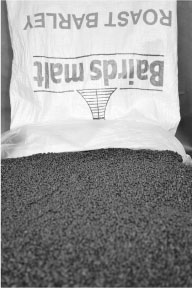Roasted Malts, a general category of specialty malts that have been roasted at high temperatures in a malt roaster and traditionally includes biscuit, caramel (or crystal), brown, chocolate, and black (also called black patent) malts. Malt roasters are also used to produce roasted barley, an unmalted product. Roasted malts contribute a wide range of flavors and aromas including caramel, toffee, burned sugar, nutty, biscuit, chocolate, and coffee and hues ranging from golden to red to black, dependingupon the roasting process and degree of roast as determined by the maltster and the style. They can add considerable bitterness when used at relatively high proportions, particularly in various types of stout. Roasted caramel malts can also provide enhanced foam creation and stability and increased viscosity (to add body or mouthfeel). Dark roasted malts can be used for flavor, but they can also be used to provide color adjustment without adding significant flavor.

Roasted barley gives beer a bitter, coffee-like flavor, often associated with stouts. pike microbrewery museum, seattle, wa
The main purpose of roasting is to create unique colors, flavors, and aromas through intense Maillard reactions, the chemical reaction of amino acids and reducing sugars, and/or caramelization of sugars at high temperatures, followed by polymerization of these newly formed molecular structures to form brown pigments. The high temperatures applied during roasting completely deactivate all enzymes developed during malting. These intense color- and flavor-producing reactions are best initiated using malt roasters, which are specifically designed to produce extremely high yet consistent temperatures, apply heat uniformly to all malt kernels, and allow for precise airflow control.
There are two distinctive categories of roasted malts—roasted “green” malts (caramel malts) and dry roasted malts (brown, chocolate, and black malts).
Caramel malts are characterized by a glassy endosperm with varying degrees of sweet flavor ranging from light caramel to toffee to burned sugar. The typical color range of caramel malts is 10° to 120° Lovibond (13 to 160 standard reference method [SRM]; 25 to 320 European Brewery Convention [EBC]).
Caramel malt is produced by bypassing the kiln and introducing germinated barley (green malt) directly into a roaster at relatively high moisture content. The green malt is quickly heated up and held at the optimum temperature of 60°C–75°C (140°F–167°F) of the starch-degrading enzymes that had developed during germination. Moisture is held inside the roaster during this stage. This process is commonly referred to as “conversion” or “stewing.” During conversion, the starchy endosperm of the malt is rapidly broken down by the enzymes into liquefied sugars; essentially, the grain husk now contains heavy wort. Following conversion, moisture is allowed to escape from the roaster and is driven from the kernels at high applied temperatures. The temperature of the kernels increases to over 200°C (400°F), whereby the liquefied sugars are caramelized or crystallized, developing the sweet caramel flavor and glassy endosperm characteristic of this style of malt. Skilled maltsters control the amount of caramelization or degree of roast using hands-on visual, aroma, and flavor sensory and “dye match” control samples.
Caramel malts are produced by malting companies throughout the world and are used in many styles of beer. In the United States, caramel malt is a signature ingredient in amber and red ales and is widely used in brown ales, Scotch ales, stouts, and porters. Used in smaller percentages, they contribute sweetness and develop rich flavors in pale ales, India pale ales, and mild ales. A distinguishing characteristic of caramel malts is their ability to improve foam development and stability and to enhance viscosity resulting from nonfermentable structures they contribute to beer.
Dry roasted malts include biscuit, brown, chocolate, and black malt and are produced by roasting kiln-dried malt at low moisture and very high temperatures to varying degrees of color and flavor. Dry roasted malts do not undergo the conversion or stewing step that caramel malts do, so the colors and flavors produced during this roasting process are the product of intense Maillard reactions and end products and therefore contribute little or no residual sweetness to a beer. There are various gradations of roast, which can be compared with gradations of roast for coffee, which can be roasted lightly, fully, or virtually burned, as is the case with espresso roasts. Brown malt, an archaic type now making a minor comeback, can be used in British mild and brown ales, Scotch ales, stouts, and porters and has a color range of 55°–170° Lovibond (75–230 SRM; 150–450 EBC). Brown malt was used to create the original porter beers that became popular in London in the 1700s. Originally it was often the base malt in porter, but it was largely replaced by a blend of pale malts and other roasted malts when roasting technology improved during the 1800s. For many years, historically minded amateur brewers had to roast approximations of brown malt themselves if they wanted to accurately reproduce early porters, but some maltsters now produce small quantities. Chocolate malt is more deeply roasted than brown malt and is named more for the color than flavor. Chocolate malts generally contribute rich, roasted coffee flavor to porters, stouts, brown ales, Scotch ales, dunkels, and other dark beers. Depending upon the maltster, typical color ratings are 200° to 500° Lovibond (270–680 SRM; 550–1,350 EBC) for pale to dark chocolate malts.
Black malt, also known as “black patent” or just “patent malt,” is so highly roasted that many flavor and aroma compounds are volatilized off, leaving only dark roasted, coffee-like, slightly astringent flavors. With a color range of 500° to 650° Lovibond (680–880 SRM; 1,350–1750 EBC), it is often used in small quantities with minimal flavor contribution to the finished beer. However, when used in higher quantities, it can add form of bitterness, an espresso-like roast bite, particularly to stouts.
